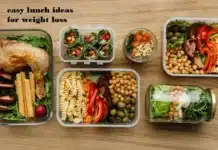Healthy Food Recipes to Lose Weight: Your Guide to Nutritious and Delicious Eating
In today’s fast-paced world, maintaining a healthy weight can often feel like a daunting task. With so many diet trends and conflicting advice, it’s easy to get lost. However, one of the most sustainable and effective ways to shed those extra pounds is through nutritious eating. By focusing on healthy food recipes, you can not only lose weight but also enjoy meals that are flavorful and satisfying.
This guide will take you through the basics of healthy eating for weight loss and provide you with a variety of recipes that are easy to prepare, rich in nutrients, and designed to keep you full without the extra calories.
Table of Contents
- Understanding the Role of Food in Weight Loss
- Key Components of a Healthy Weight Loss Diet
- The Importance of Portion Control
- Healthy Eating Myths Busted
- Healthy Breakfast Recipes for Weight Loss
- 5.1 Avocado and Egg Toast
- 5.2 Greek Yogurt with Berries and Chia Seeds
- 5.3 Oatmeal with Almond Butter and Banana
- Nutritious Lunch Ideas
- 6.1 Quinoa Salad with Grilled Chicken
- 6.2 Zucchini Noodles with Pesto and Shrimp
- 6.3 Lentil Soup with Spinach and Carrots
- Low-Calorie Dinner Recipes
- 7.1 Baked Salmon with Asparagus
- 7.2 Grilled Chicken with Steamed Vegetables
- 7.3 Stuffed Bell Peppers with Turkey and Brown Rice
- Quick and Easy Snacks for Weight Loss
- 8.1 Apple Slices with Peanut Butter
- 8.2 Mixed Nuts and Seeds
- 8.3 Carrot Sticks with Hummus
- The Role of Hydration in Weight Loss
- Meal Prepping for Success
- Intermittent Fasting: A Complementary Approach?
- Foods to Avoid When Trying to Lose Weight
- The Importance of Fiber-Rich Foods
- Balancing Macronutrients for Optimal Weight Loss
- FAQs on Healthy Food Recipes to Lose Weight
1. Understanding the Role of Food in Weight Loss
Losing weight isn’t just about cutting calories—it’s about consuming the right kinds of food that nourish your body, improve metabolism, and promote satiety. When you eat nutrient-dense foods, you give your body the vitamins, minerals, and macronutrients it needs to function efficiently, burn fat, and maintain muscle mass.
A diet rich in whole foods—fruits, vegetables, lean proteins, and whole grains—helps keep your blood sugar levels stable, reduces cravings, and prevents the overeating that often comes with processed, sugary foods.
2. Key Components of a Healthy Weight Loss Diet
To create a successful weight loss plan, it’s important to understand what makes a diet healthy and sustainable. Here are the key components:
- Protein: Helps build and repair tissues, keeps you full longer, and supports muscle maintenance.
- Healthy Fats: Found in avocados, nuts, seeds, and fish, healthy fats are essential for brain function and hormone production.
- Complex Carbohydrates: Unlike simple carbs (e.g., white bread and sugary snacks), complex carbs like quinoa, oats, and brown rice provide slow-releasing energy and are full of fiber.
- Fiber: Promotes digestion, reduces hunger, and helps control blood sugar levels.
- Hydration: Drinking plenty of water is essential to keep your metabolism running smoothly and prevent overeating.
3. The Importance of Portion Control
Even when you’re eating healthy foods, portion control is vital. Overeating, even with nutritious ingredients, can stall weight loss. Learning to listen to your body’s hunger and fullness cues, measuring portions, and using smaller plates can all help prevent overeating.
It’s also important to understand that weight loss is not about deprivation but moderation. You can still enjoy your favorite foods, just in smaller amounts or healthier versions.
4. Healthy Eating Myths Busted
There are many myths surrounding what it takes to lose weight through healthy eating. Here are a few common misconceptions:
- Myth 1: All fats are bad. The truth is, healthy fats are vital for weight loss and overall health. Focus on unsaturated fats from sources like olive oil, nuts, and fatty fish.
- Myth 2: Carbs make you gain weight. Complex carbohydrates, like whole grains and vegetables, are important for energy and can be part of a healthy weight loss diet.
- Myth 3: Skipping meals helps you lose weight. Skipping meals can lead to overeating later in the day, which can sabotage your efforts. Eating balanced meals throughout the day keeps your metabolism steady.
5. Healthy Breakfast Recipes for Weight Loss
Breakfast is often considered the most important meal of the day. Eating a balanced, nutrient-dense breakfast can kickstart your metabolism and prevent overeating later.
5.1 Avocado and Egg Toast
Ingredients:
- 1 slice whole grain bread
- 1/2 avocado
- 1 poached egg
- Salt, pepper, and red pepper flakes
Instructions:
- Toast the bread.
- Mash the avocado and spread it on the toast.
- Top with a poached egg and season with salt, pepper, and red pepper flakes.
This recipe is packed with healthy fats, protein, and fiber, which will keep you full for hours.
5.2 Greek Yogurt with Berries and Chia Seeds
Ingredients:
- 1 cup plain Greek yogurt
- 1/2 cup mixed berries
- 1 tablespoon chia seeds
- Honey (optional)
Instructions:
- In a bowl, mix the Greek yogurt, berries, and chia seeds.
- Drizzle with honey if desired.
Greek yogurt is high in protein, and the chia seeds add fiber and healthy fats, making this a perfect, low-calorie breakfast.
5.3 Oatmeal with Almond Butter and Banana
Ingredients:
- 1/2 cup rolled oats
- 1 cup almond milk
- 1 tablespoon almond butter
- 1/2 banana, sliced
Instructions:
- Cook the oats in almond milk according to the package instructions.
- Stir in the almond butter and top with banana slices.
This breakfast is a great source of fiber and protein, helping you stay satisfied all morning.
6. Nutritious Lunch Ideas
Lunch should be a balance of protein, fiber, and healthy fats. These recipes are designed to be filling but low in calories, perfect for weight loss.
6.1 Quinoa Salad with Grilled Chicken
Ingredients:
- 1/2 cup cooked quinoa
- 1 grilled chicken breast, sliced
- 1/2 cup cherry tomatoes, halved
- 1/4 cucumber, diced
- 1 tablespoon olive oil
- Lemon juice, salt, and pepper
Instructions:
- Combine quinoa, chicken, tomatoes, and cucumber in a bowl.
- Drizzle with olive oil and lemon juice, and season with salt and pepper.
Quinoa is rich in protein and fiber, while the chicken adds lean protein, making this salad both satisfying and nutritious.
6.2 Zucchini Noodles with Pesto and Shrimp
Ingredients:
- 2 zucchini, spiralized into noodles
- 1/4 cup homemade pesto (or store-bought)
- 8-10 shrimp, cooked
- Cherry tomatoes for garnish
Instructions:
- Toss the zucchini noodles with the pesto.
- Top with cooked shrimp and garnish with cherry tomatoes.
Zucchini noodles are a low-calorie, low-carb alternative to pasta, while shrimp provides a lean source of protein.
6.3 Lentil Soup with Spinach and Carrots
Ingredients:
- 1 cup cooked lentils
- 2 cups vegetable broth
- 1 carrot, sliced
- 1 handful of spinach
- Garlic, salt, and pepper
Instructions:
- In a pot, combine lentils, broth, carrots, and garlic.
- Bring to a boil, then reduce heat and simmer for 15 minutes.
- Stir in spinach and cook until wilted.
Lentils are a fantastic source of plant-based protein and fiber, making this soup both nutritious and filling.
7. Low-Calorie Dinner Recipes
Dinner is often the time when people overeat, so it’s important to keep your meals light but filling. These recipes are designed to provide plenty of nutrients without too many calories.
7.1 Baked Salmon with Asparagus
Ingredients:
- 1 salmon fillet
- 1 bunch asparagus
- 1 tablespoon olive oil
- Lemon slices, salt, and pepper
Instructions:
- Preheat the oven to 400°F (200°C).
- Place the salmon on a baking sheet and arrange asparagus around it.
- Drizzle with olive oil, top with lemon slices, and season with salt and pepper.
- Bake for 12-15 minutes, until the salmon is cooked through.
Salmon is rich in omega-3 fatty acids, which are great for heart health and weight loss, while asparagus is low in calories but high in nutrients.
7.2 Grilled Chicken with Steamed Vegetables
Ingredients:
- 1 chicken breast, grilled
- 1 cup broccoli florets
- 1/2 cup sliced carrots
- 1 tablespoon olive oil
**Instructions:
**
- Grill the chicken until fully cooked.
- Steam the broccoli and carrots until tender.
- Drizzle with olive oil and serve with the chicken.
This is a simple, protein-packed dinner that is low in calories but high in nutrients.
7.3 Stuffed Bell Peppers with Turkey and Brown Rice
Ingredients:
- 4 bell peppers
- 1/2 pound ground turkey
- 1 cup cooked brown rice
- 1/4 cup diced tomatoes
- Garlic, salt, and pepper
Instructions:
- Preheat the oven to 375°F (190°C).
- Cut the tops off the bell peppers and remove the seeds.
- In a skillet, cook the ground turkey with garlic, salt, and pepper.
- Mix in the rice and tomatoes, then stuff the mixture into the bell peppers.
- Bake for 20-25 minutes.
This recipe is a great way to enjoy a filling meal while keeping your calorie intake in check.
8. Quick and Easy Snacks for Weight Loss
Snacking is a common pitfall for many people trying to lose weight. However, healthy snacks can keep your hunger at bay between meals and prevent overeating later in the day.
8.1 Apple Slices with Peanut Butter
A classic snack that’s both satisfying and nutritious. Apples are high in fiber, while peanut butter provides healthy fats and protein.
8.2 Mixed Nuts and Seeds
A small handful of nuts and seeds, like almonds, walnuts, and chia seeds, is a great source of healthy fats, protein, and fiber. Be mindful of portion size, as nuts are calorie-dense.
8.3 Carrot Sticks with Hummus
Carrots are low in calories and high in vitamins, and hummus is a good source of healthy fats and plant-based protein.
9. The Role of Hydration in Weight Loss
Drinking enough water is essential for weight loss. Staying hydrated helps boost your metabolism, suppresses your appetite, and flushes out toxins. Aim for at least 8 glasses of water a day, and consider drinking a glass before meals to prevent overeating.
10. Meal Prepping for Success
Meal prepping is a powerful tool for staying on track with your weight loss goals. By preparing meals in advance, you eliminate the temptation to grab unhealthy, convenience foods. Plus, it saves you time during the busy week.
When meal prepping, focus on creating balanced meals with lean proteins, whole grains, and plenty of vegetables. Store your meals in individual containers for easy grab-and-go options.
11. Intermittent Fasting: A Complementary Approach?
Intermittent fasting (IF) has gained popularity as a weight-loss strategy. It involves cycling between periods of eating and fasting. Some people find that it helps them reduce calorie intake and control hunger more effectively. Common methods include the 16/8 method (16 hours fasting, 8 hours eating) or the 5:2 diet (eating normally for 5 days, reduced calories for 2 days).
While intermittent fasting can be effective for some, it’s important to listen to your body and ensure you’re still getting the nutrients you need.
12. Foods to Avoid When Trying to Lose Weight
Certain foods can sabotage your weight loss efforts by adding extra calories without providing much nutritional value. These include:
- Sugary drinks like soda and sweetened coffee
- Processed snacks like chips and cookies
- Refined grains such as white bread and pasta
- Fried foods and fast food
- Alcohol, which is high in empty calories
Focusing on whole, unprocessed foods is key to losing weight and maintaining a healthy diet.
13. The Importance of Fiber-Rich Foods
Fiber is a crucial component of any weight loss diet. It helps regulate your digestive system, keeps you full, and supports stable blood sugar levels. High-fiber foods include vegetables, fruits, legumes, and whole grains.
Incorporating fiber-rich foods into every meal can help prevent overeating and aid in long-term weight loss.
14. Balancing Macronutrients for Optimal Weight Loss
A balanced diet includes the right mix of macronutrients—carbohydrates, proteins, and fats. Each macronutrient plays a specific role in weight loss:
- Carbohydrates provide energy, but focus on complex carbs like whole grains and vegetables.
- Proteins help build muscle and keep you full.
- Fats (the healthy kind) are essential for hormone production and overall health.
By balancing these nutrients, you can create meals that are satisfying, nutritious, and effective for weight loss.
15. FAQs on Healthy Food Recipes to Lose Weight
1. Can I eat carbs and still lose weight?
Yes, as long as you choose complex carbs like whole grains, fruits, and vegetables, which provide fiber and energy.
2. How often should I eat when trying to lose weight?
It’s best to eat balanced meals every 3-4 hours to keep your metabolism steady and prevent overeating.
3. What is the best way to meal prep for weight loss?
Focus on lean proteins, whole grains, and plenty of vegetables. Store meals in portioned containers for convenience.
4. Are healthy fats important in a weight loss diet?
Yes, healthy fats from sources like avocados, nuts, and olive oil help you stay full and provide essential nutrients.
5. How much protein do I need when trying to lose weight?
Aim for about 0.6 to 1 gram of protein per pound of body weight, depending on your activity level.
6. Can I lose weight without giving up snacks?
Yes, by choosing healthy snacks like fruits, vegetables, and nuts, you can satisfy hunger without overeating.


